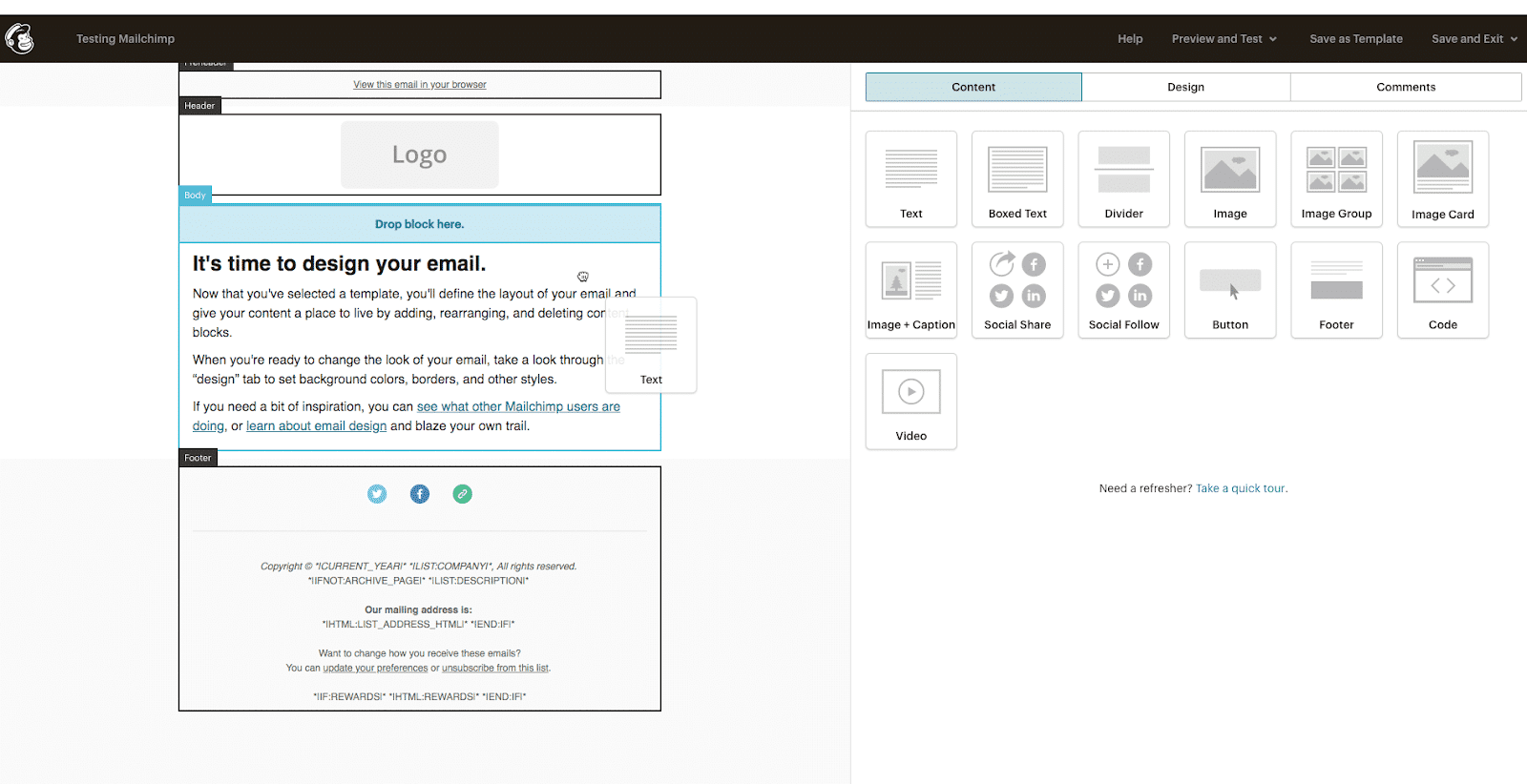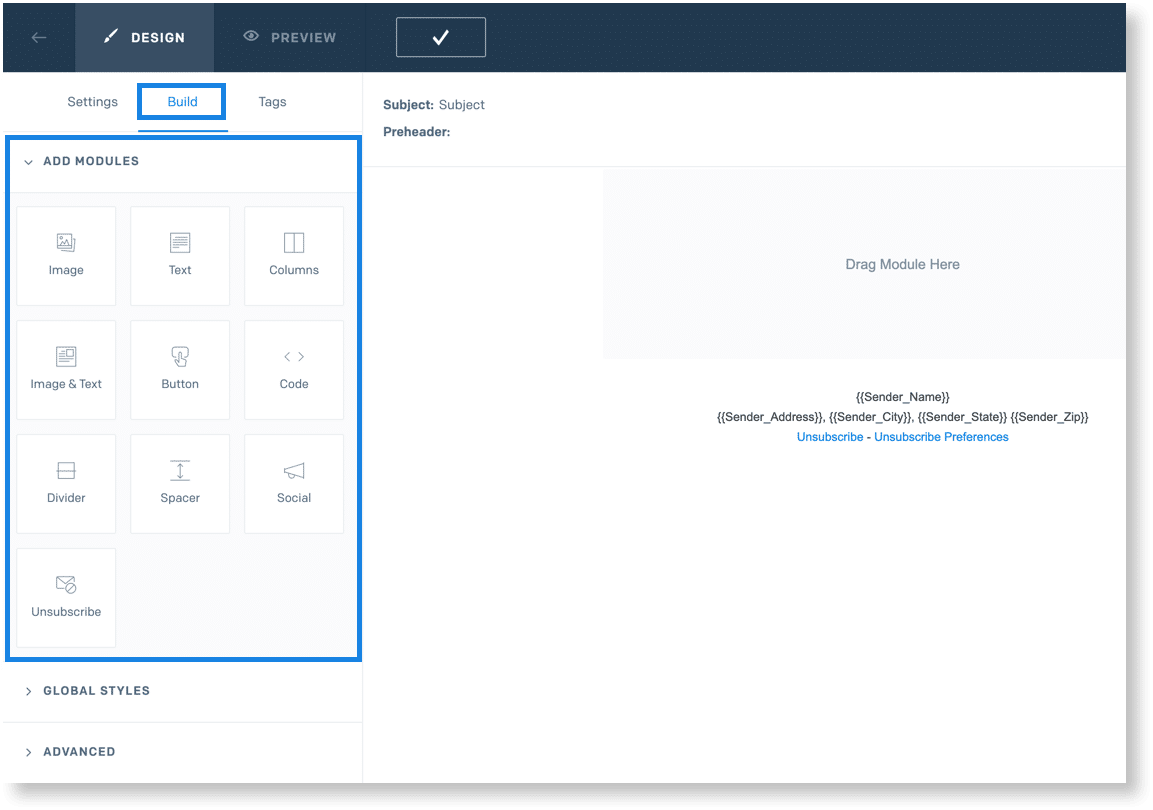If you’re about to pick your ESP, you can’t complain about the lack of options. There are dozens of fantastic tools on the market and more and more are catching up with the leaders. SendGrid and Mailchimp are among the most popular choices.
Mailchimp has been the top solution for email marketers for many years. SendGrid has topped the list of best transactional email providers. Ultimately, they have both expanded into each other’s markets and developed solutions for sending any types of emails. Deep inside, they’re still quite different and each will be perfect for slightly different needs.
If you’re still hesitating when choosing between them, check our comparison and pick the one that’s perfect for your needs.
Mailchimp vs SendGrid – a brief description of each
Mailchimp (previously known as MailChimp) is a marketing platform and a serious player on the transactional emails market too. It was founded in 2001 by Mark Armstrong, Ben Chestnut, and Dan Kurzius.
Mailchimp is definitely the bigger of the two, with nearly 1000 employees and around $600M of annual revenue. Initially, a marketing platform aimed at businesses small and big, it also evolved into a transactional email provider with its acquisition of Mandrill. With its generous freemium plan and accessibility, the Atlanta, Georgia-headquartered company is one of the market leaders.
SendGrid (or actually, Twilio’s SendGrid as it’s often referred to since the 2018 acquisition) is a Denver, Colorado-based giant of transactional and marketing emails. It was founded in 2009 by the trio of Isaac Saldana, Tim Jenkins, and Jose Lipez.
From three, it grew to over 400 employees spread across its offices in the US and London, UK, generating $111.9M of annual revenue as reported in 2017. Many developers’ favorite, it has managed to maintain a steady growth thanks to its robust API, countless integrations and reliability.
trends.embed.renderExploreWidget(“TIMESERIES”, {“comparisonItem”:[{“keyword”:”mailchimp”,”geo”:”UA”,”time”:”today 12-m”},{“keyword”:”sendgrid”,”geo”:”UA”,”time”:”today 12-m”}],”category”:0,”property”:””}, {“exploreQuery”:”geo=UA&q=mailchimp,sendgrid&date=today 12-m,today 12-m”,”guestPath”:”https://trends.google.com:443/trends/embed/”}); trends.embed.renderExploreWidget(“TIMESERIES”, {“comparisonItem”:[{“keyword”:”mailchimp”,”geo”:”UA”,”time”:”today 12-m”},{“keyword”:”sendgrid”,”geo”:”UA”,”time”:”today 12-m”}],”category”:0,”property”:””}, {“exploreQuery”:”geo=UA&q=mailchimp,sendgrid&date=today 12-m,today 12-m”,”guestPath”:”https://trends.google.com:443/trends/embed/”});As you can see on the chart above, Mailchimp picked up much earlier and it’s maintained a much higher interest from the public ever since.
But does ‘a more popular’ mean ‘better’ in this situation? Let’s see.
Comparing Mailchimp vs SendGrid
We’re going to look at various aspects of each platform and give our thoughts on which does better in a particular field. In the end, we’ll also suggest which tool will be better for your particular needs. Stay with us!
Email marketing capabilities
Email marketing is where Mailchimp shines the most. From the very inception of the company, marketing has been the core of the business and small/medium companies have been their focus. For that reason, sending an email marketing campaign with Mailchimp is a very straightforward experience.
With Mailchimp, you can easily manage contact lists and see the performance of each. The platform comes with support for user segmentation, dynamic fields, advanced tracking of deliveries and clicks, and a lot more. Dozens of templates for any occasion can be freely used, customized and saved for future use.
All of this is packed in an intuitive, easy, and fun to move around interface. If you’re looking for an effortless experience when sending marketing emails, maybe you won’t have to look much further.
Mailchimp is also big in the marketing automation field. It features predefined and customizable automations that can personalize the experience of users without almost any effort on your site. The platform is nothing short of being the ultimate email marketing provider.
SendGrid also offers email marketing features, but it’s far behind Mailchimp in this race. It started off as a transactional email platform. For a few years now, it’s been trying to transition into an all-email provider but it’s not there yet.
Today, it features a handful of templates, a drag & drop builder and comprehensive analytics. It also comes with marketing automation features, customizable with its robust API. It can be successfully used for running SendGrid marketing campaigns. But companies do it mainly because they already use the platform for transactional purposes.
Verdict: Mailchimp. There’s a lot more in store for email marketers and it’s all packed into a very pleasant experience.
Transactional email capabilities
Mailchimp isn’t meant for sending transactional emails, but thanks to its acquisition of Mandrill, it also offers transactional emails to its paid users. As a result, from a non-existent participant on the market, Mailchimp quickly rose to be one of the top solutions. Assuming you need to send both transactional and marketing emails, Mailchimp in its current shape can be the tool for this.
Mandrill’s API offers a number of features, such as dedicated IPs, authentications and multi-domain support. It also comes with extended analytics built into the platform. Mandrill integrates with third-party services, such as CMSes, via numerous, continuously-supported plugins.
Transactional emails are the core of SendGrid‘s business and to no surprise, it’s an absolute killer in this domain. It’s API’s have got everything a developer needs – easy setup, complete documentation, countless integrations and libraries for a number of popular frameworks. If transactional emails are your main (or only) focus, you can’t pick much better.
SendGrid comes with a full set of authentications (DKIM, SPF, and DMARC) and support for both shared and private IPs. On top of that, it offers an unmatched set of analytics, including real-time stats and webhooks. While they’re hosted on their platform, they can also be downloaded for external use.
SendGrid also bolsters one of the best delivery rates on the market. According to their internal data, the participants of their Expert Services program enjoy a whopping 97% of emails delivered right into recipients’ inboxes. If you’re struggling with poor deliverability, SendGrid might be the cure you were looking for.
Verdict: SendGrid. Mailchimp’s Mandrill isn’t far behind but SendGrid is an absolutely elite solution in the transactional emails field.
Design capabilities
When designing emails with Mailchimp, you can pick from a dozen or so templates. You can also create your own from scratch or upload, for example, an HTML code right into the editor.

You can then choose from a number of fields and move them freely around the design. Feel free to also add media and custom HTML/CSS that you can apply to the whole content or to its particular sections.
SendGrid also offers templates and a drag & drop builder, referred to as a design editor. You can pick from a number of blocks, add and move them freely around the design, as well as edit the HTML behind each.

The difference-maker is, however, the code editor. Here, you can use one of the available templates and change the code behind them, seeing your progress on a split-screen view. You can pick from a number of available blocks and edit them freely. The editor will alert you when it detects any potential problems so you can fix them right away.
Verdict: SendGrid. Mailchimp might have a slight edge with the number of templates or blocks available. But, if you need more advanced toys and won’t shy away from a bit of coding, SendGrid should be your tool of choice. It takes the lead here with its fully customizable experience and real-time error flagging.
Email testing capabilities
When designing an email in Mailchimp, the only native option is to send a test email to yourself or your colleagues. This can help you avoid some basic issues, but what might look good on your devices, might render in a completely different way on your clients’ devices.
For that reason, Mailchimp also features a Litmus-powered email preview that lets you view your design just as it would look on dozens of popular devices, both on mobile and web. Note that you can use this feature in a limited capacity without a Litmus subscription.
SendGrid, on the other hand, offers a number of features for testing emails. This includes testing against spam filters, previews for different clients, and devices and link validation. All of this is built into the platform, letting you refine your design right on the spot.
As an alternative, you can also send test emails to up to 10 addresses at a time.
Verdict: SendGrid by a wide margin. It offers a lot more in this field without forcing you to use 3rd party services. If you need to quickly make sure your emails look just the way you designed them, you’ll be happy with SendGrid.
Note that neither of these tools is suitable for properly testing transactional emails and protecting yourself from accidentally spamming your customers. For this, you should use a dedicated email testing solution, such as Mailtrap.
Ease of use
Mailchimp has been a go-to choice for small and medium businesses in particular, since the very beginning. The platform has always been really easy to use and the fun, easy-going interface brought the brand a large fanbase.
Mailchimp hardly requires any introduction and if you’re new to it, you can configure and send a marketing campaign nearly on the spot. Easy to use email builder, templates and intuitive automations make it a favorite tool for the less technical user base.
Those more interested in the API will also find SendGrid to be a pleasure to use. Simple, yet powerful possibilities are well documented and written in an easy to grasp language. Excellent tutorials make the platform accessible to everyone.
Verdict: Mailchimp is the preferred choice for thousands of marketers and for a reason. Sending marketing emails doesn’t get much easier. SendGrid is a developer-focused platform that, naturally, won’t be as accessible as its competitor. But among the many other developer-focused solutions on the market, it’s considered to be one of the most straightforward ones.
Pricing
Both platforms offer pricing dependent not only on the volume, but also on the set of features you’re going to need.
Mailchimp offers a generous free tier with up to 2,000 contacts and 10,000 emails sent on a monthly basis. The set of features is somewhat limited but will likely be sufficient if you’re a startup or a small company. As a result, you can even use Mailchimp free of charge until you grow bigger.
Paid plans start from $9.99/month, with things like custom templates and marketing automation available only on more expensive plans (starting from $14.99). As a reminder, to use Mandrill for transactional email, you’ll need to be on a paid plan and purchase blocks of emails separately.
SendGrid offers a similar free tier to those of you with limited sending needs. Up to 2,000 contacts and 6,000 emails sent every month are included for free. In this plan, you can design and send an email, take advantage of event-based automations and even perform a few email tests. Higher volume is available on plans starting from $50/month.
If you’re more inclined to use SendGrid’s API, you can try it with up to 40,000 emails sent in the first 30 days. Later on, you’ll probably need to upgrade to one of the paid plans (starting from $14.95/month) as only 100 emails/month are available free of charge.
As both services are priced very differently, it’s worth picking some dummy data and comparing them. Let’s look at two possible scenarios.
Marketing emails
Let’s assume you need the tool for sending your marketing campaigns but also need access to automations within your plan. For that, you’ll want to be on the ‘Advanced’ SendGrid plan and a ‘Standard’ Mailchimp plan. The table below shows various possible volumes and pricing for each platform.
| Contacts | Emails sent/month | Mailchimp’s pricing | SendGrid’s pricing |
| 2,000 | 15,000 | $49.99 | $60 |
| 5,000 | 40,000 | $74.99 | $60 |
| 30,000 | 150,000 | $249 | $250 |
| 50,000 | 300,000 | $299 | $450 |
Marketing + transactional emails
For a different scenario, let’s assume you want to utilize SendGrid API for sending all kinds of emails. On Mailchimp, you’ll want to use its add-on, Mandrill, but also keep an active plan for sending marketing emails. Well, you’ll need to keep paying for one either way if Mandrill is the tool of your choice.
Let’s bump up the volume of emails sent from the last table and keep the number of contacts intact. Note that only Mailchimp takes the latter into account. SendGrid’s API plans depend solely on the volume of emails sent. For both platforms, we’ll assume you start on the ‘Essentials’ plans but for SendGrid, you would need to upgrade to ‘Pro’ once you go above the 100k/month threshold. The table takes this into account.
| Marketing contacts | Emails sent/month | Mailchimp’s pricing | SendGrid’s pricing |
| 2,000 | 50,000 | $69.99 | $14.95 |
| 5,000 | 100,000 | $129.99 | $29.95 |
| 30,000 | 500,000 | $619 | $249 |
| 50,000 | 1,400,000 | $1,155 | $749 |
Verdict: If you only need to send marketing emails, both platforms offer similar prices and the set of features offered on each plan should help you decide between them. However, when both transactional and marketing emails are in question, SendGrid offers much more favorable pricing.
Disclaimer: The thing about prices is that they tend to change. The tables below should give you a general idea about how both compare to each other at the time of writing (January 2020). Before committing to either (or discarding both), check individual pricing tables for the most accurate numbers.
Users’ opinions
Let’s listen to the actual users of both platforms and look at their ratings.
Here are the average scores of both platforms on popular rating services:
| Service | Mailchimp’s score | SendGrid’s score |
| G2 | 4.3/5 | 4.1/5 |
| GetApp | 4.48/5 | 4.34/5 |
| Capterra | 4.5/5 | 4.3/5 |
| Trustpilot | 1.5/5 | 3/5 |
| Trustradius | 8.3/10 | 8.8/10 |
| SoftwareAdvice | 4.48/5 | 4.34/5 |
Users commonly compliment both platforms on:
Mailchimp:
- Generous free tier
- Simple, easy-to-use interface
- Easy integrations with external services
- Smooth user segmentation
- Custom templates
- Excellent mail tracking
SendGrid:
- Robust analytics
- Support for all types of emails
- Favorable pricing
- Easy setup and general easiness of use of API
- Extensive knowledge base and documentation
- Reliability
- Available integrations
They also sometimes complain, mainly about:
Mailchimp:
- Expensive pricing on higher volumes
- The need for paid Mailchimp subscriptions even if you only use Mandrill
- Inadequate API
- Insufficient support options
SendGrid:
- Difficult to fully use for non-technical users
- Insufficient security
- Poor customer support
So, which one should you choose?
If you still haven’t made a decision, here are our top three reasons for picking each of these platforms.
When to choose Mailchimp:
- You need a simple tool for sending marketing emails
Mailchimp is as simple as it gets. The whole process of sending emails can be learnt in half an hour, and the interface is fun and easy to navigate. Mailchimp’s got everything you need to get started with email marketing.
- You want to be able to easily set up some marketing automations
Mailchimp offers some great, customizable automations you can set up for your audience. You can easily automate various boring processes and send automated, yet fairly personalized emails to your contacts in no time. All of this, without any extra costs on top of a regular Mailchimp subscription.
- You have a limited budget
If you’re just getting started or have limited email needs, Mailchimp’s free tier might be just your thing for the time being. The limit of 2k contacts (& 10k emails/month) will allow you to stay in touch with your followers without incurring any costs, and when your needs grow, you’ll be automatically upgraded to their basic plan.
When to choose SendGrid:
- You need to send both transactional and marketing emails
SendGrid’s pricing is much more favorable for more sophisticated needs. Also, it’s very straightforward – the more you send, the more you pay. Not having to maneuver between two different tools, as is the case with Mailchimp and Mandrill, will give you peace of mind too.
- You’re a developer and have more complex needs
SendGrid is meant mainly for developers. It comes with a slightly steeper learning curve, but it rewards you with a vast array of advanced tools for sending any emails. Their API is famous for its simplicity and quality. The analytics have everything you would expect from them. The entire platform is well documented and easy to get started with. Ultimately, it offers more than Mailchimp and with a very reasonable price tag.
- You require an exceptional deliverability
One of SendGrid’s key advantages is fantastic deliverability. Their team puts a strong focus on filtering out potential abusers and their IPs are known in the industry for high sending quality. Those participating in the Expert Services program enjoy some of the best delivery rates on the planet.
Wrapping up
We hope we made the choice a bit easier for you. If you’re only after transactional emails, you should also check out our Mandrill vs Sendgrid vs Mailgun comparison.
Whichever platform you eventually choose, don’t forget to test your emails. Using production data for this purpose is not the greatest idea. Need something safer? Try Mailtrap – an environment for pre-production email testing.
Until next time!


